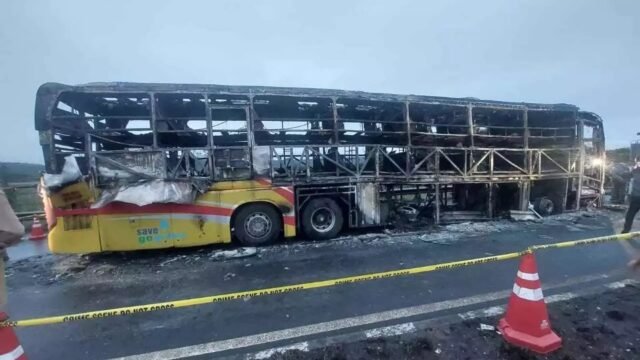Hyderabad:Official sources in Telangana have revealed that the explosion of lithium-ion batteries from 243 new mobile phones — worth about Rs 49 lakh — illegally stored in the luggage cabin may have triggered the blaze in the Vemuri Kaveri Travels bus that claimed 19 lives, if contributed to it. The blast tripped the ignition system and jammed the hydraulic door, trapping the passengers inside the ill-fated bus, it was stated.
According to investigators, a Hyderabad-based businessman, Manganath, had handed over 234 boxes of mobile phones to driver Shiva Narayan and co-driver V. Laxman, for delivery to a dealer in Bengaluru against an online delivery order. “The driver illegally agreed to carry the consignment. The phones were packed in cardboard boxes and loaded in the luggage cabin,” an RTA officer said.
Police have taken Manganath into custody for questioning and are preparing to hand him over to Andhra Pradesh police for investigation. Sources said Mantanath visited the accident spot after the tragedy and returned to Hyderabad before being traced. A Telangana forensic expert confirmed that a “massive lithium-ion battery explosion” was the primary cause. “Our team and the Andhra Pradesh forensic department both confirmed that eyewitnesses heard a loud blast from the luggage section before the fire engulfed the bus,” the expert said.
Andhra Pradesh fire services DG P. Venkataramana said the mobile phones stored in the luggage compartment had fuelled the fire. “The batteries exploded and triggered the air-conditioner compressors to burst. The aluminium flooring of the bus melted from the heat,” he said.
Telangana RTA officials investigating the transport angle said the use of lightweight aluminium instead of iron in the bus body made the vehicle faster but also more combustible. “Such design compromises increase the intensity of fire and reduce survival chances,” an official noted.
More than 2,200 private buses operate daily from the twin cities to destinations in other states. Drivers, incentivised for early arrivals, often cross 120 kmph, with little to no speed monitoring on national highways, a driver named M. Sudershan said.
Joint Commissioner (RTA-Telangana) C. Ramesh told Deccan Chronicle that carrying cargo other than passenger luggage is strictly prohibited under the Motor Vehicles Act. “Owners of buses transporting merchandise face suspension or cancellation of their All-India Permits,” he warned. Ramesh added that many operators evade high Telangana road tax by obtaining National or Temporary Permits from states like Odisha, Nagaland, Mizoram, Assam and Uttarakhand. “We are cross-verifying these permits. Any expired or irrelevant documentation will lead to bus seizures,” he said.
Forensic Science Laboratory (FSL) joint director Narakuti Venkanna, who heads the Telangana CLUES team, explained the science behind the explosion: “Lithium-ion batteries have a high energy density. When overheated or damaged, they enter a process called thermal runaway, where temperature rises uncontrollably, melting the separators between the anode and cathode. This causes a short circuit and rapid gas release, igniting nearby batteries.”
He added that the chain reaction could cause hundreds of mobile batteries to explode in succession, amplifying the intensity of the fire. “In this case, the first explosion in the luggage cabin spread instantly to other mobile batteries and the AC system, leading to a catastrophic blaze,” Venkanna said.
Infographics: Key Findings from Bus Fire Probe
Illegal Cargo: Drivers collected 234 boxes of new mobile phones from city businessman Manganath to deliver illegally to Bengaluru.
Trigger Point: Lithium-ion batteries in the luggage cabin exploded, igniting the fire that trapped passengers.
Battery Risk: These batteries, common in smartphones, have high energy density and can explode if overheated or damaged, said Narakuti Venkanna, TG CLUES team head and Joint FSL Director.
Thermal Runaway: The explosion began when battery cells overheated, causing the separator between anode and cathode to melt and short-circuit, releasing flammable gases.
Chain Reaction: One battery’s blast triggered hundreds of others, followed by explosions of AC compressors, intensifying the fire.
Structural Impact: The aluminium bus body melted under extreme heat, accelerating the blaze and blocking passenger escape routes.







